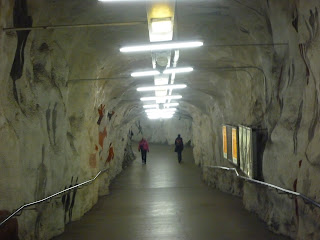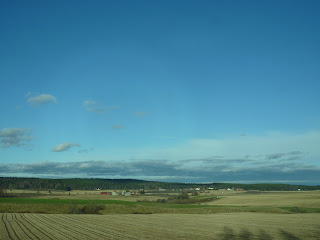I go to
bed early and sleep for twelve hours in the completely dark in-cabin which nearly
makes me miss breakfast. The Russian lady in my cabin offers me one of her many
breakfast eggs, they are small and freckled, and it’s only when I already
cracked one open that I realize they are raw. I feel it would be awkward to
refuse now, so I do as she tells me and open it at the top, put in salt and
empty it in one go. It doesn’t really taste of much, so, not all that bad. I
take breakfast at a window table with a view over the grey sea below a cover of
heavy clouds. Quite dark for nearly ten. But then again, while the time on the
boat will remain Finnish we already entered the Central European Time zone, so
actually it’s before nine. And I see a rainbow which seems to be really close
by. What a nice start of the day.
Time
passes easily with reading, writing, sharing pictures, talking – and listening
to a group of German seniors. When we get closer to the coast it’s also warmer
outside. I guess the bright white blinking we see for a while belongs to a
lighthouse on Rügen, the biggest German island and popular weekend resort for
many people in my region. And there are birds now! Seagulls floating in and out
of the light cones of our windows somehow make the air seem like something they
swim in. We slow down and nearly stop altogether when Lübeck already is in
sight. Then, like the seagulls, but much quicker and muck bigger, another
Finnlines ferry dashes past the window, some minutes later followed by the Nils
Holgersson, a big ferry going to Sweden. Now our ship gains speed again, we had
to wait for our slot at the quay. After a last waiting period during which the
trucks disembark from the first cargo deck, a port bus takes us to the
“Hafenhaus”. Back on solid ground is also back to reality: The worker driving
the bus tells the steward who accompanies us about the pending labor dispute at
the port. I had planned to take the train to my parents, but luckily the
offered to give me a ride, so they have already spent some time here watching
the ship tracker. It’s nearly midnight and I’m home.















































